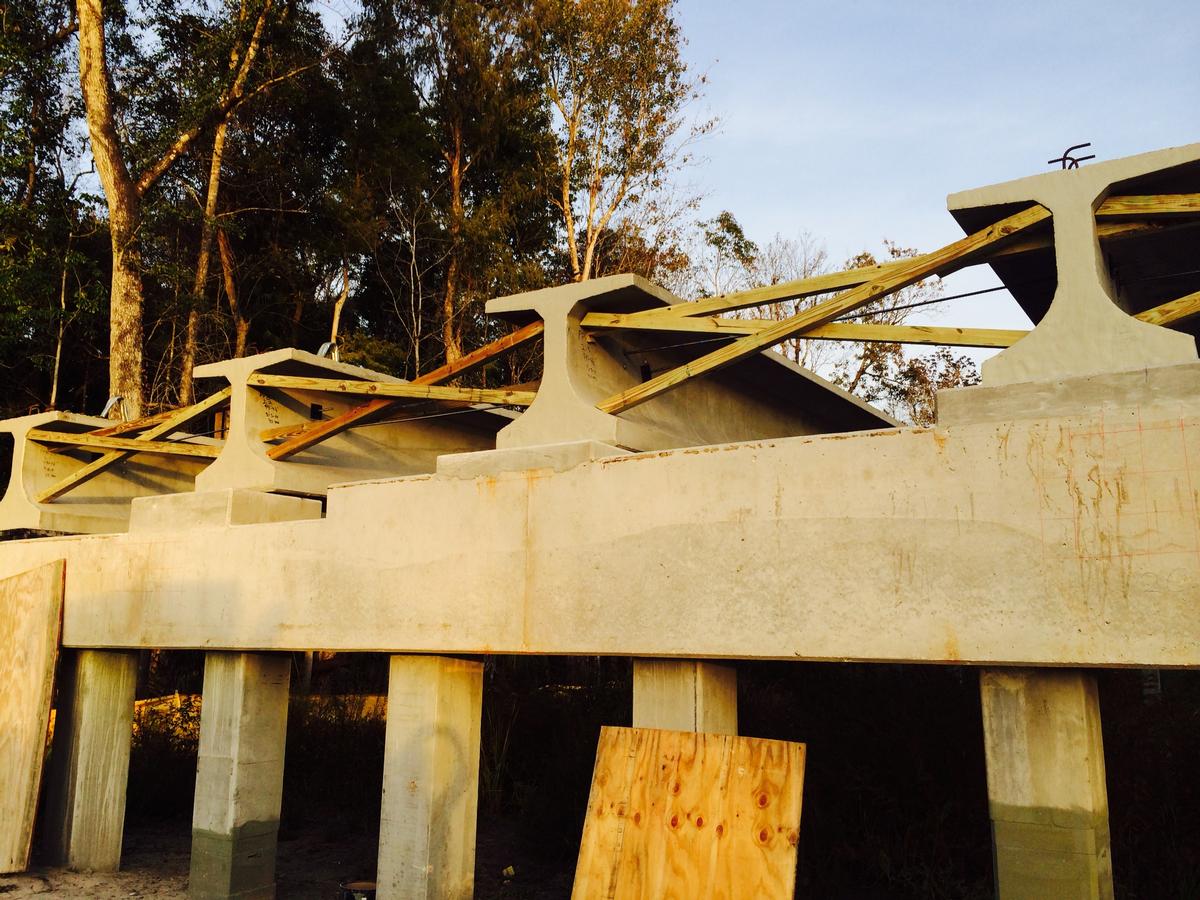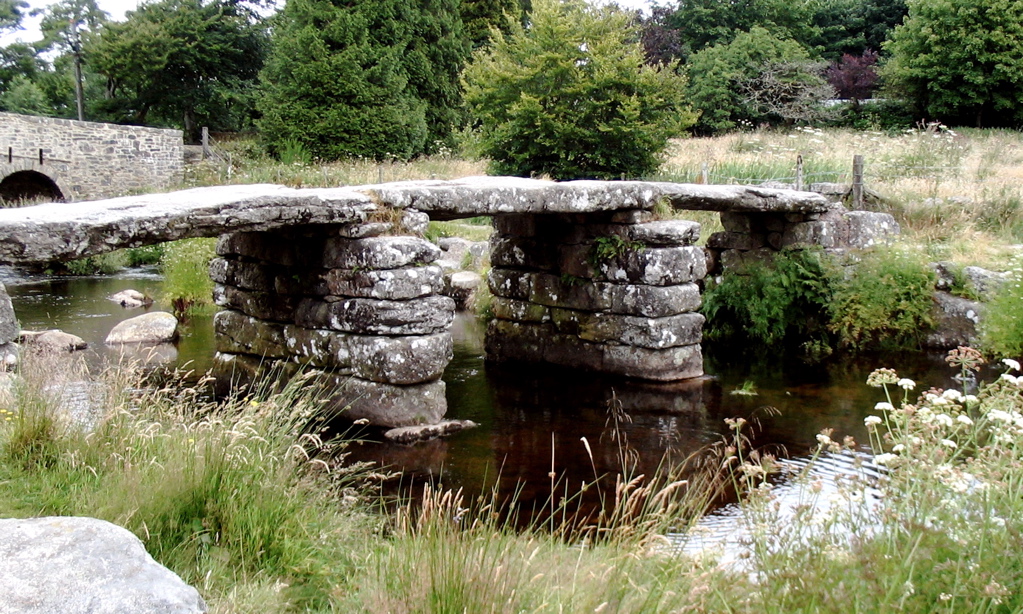|
Beam Bridge
Beam bridges are the simplest structural forms for bridge spans supported by an abutment or pier at each end. No moments are transferred throughout the support, hence their structural type is known as '' simply supported''. The simplest beam bridge could be a log (see log bridge), a wood plank, or a stone slab (see clapper bridge) laid across a stream. Bridges designed for modern infrastructure will usually be constructed of steel or reinforced concrete, or a combination of both. The concrete elements may be reinforced or prestressed. Such modern bridges include girder, plate girder, and box girder bridges, all types of beam bridges. Types of construction could include having many beams side by side with a deck across the top of them, to a main beam either side supporting a deck between them. The main beams could be I-beams, trusses, or box girders. They could be half-through, or braced across the top to create a through bridge. Since no moments are transferred, t ... [...More Info...] [...Related Items...] OR: [Wikipedia] [Google] [Baidu] |
Box Girder Bridge
A box girder bridge, or box section bridge, is a bridge in which the main beam (structure), beams comprise girders in the shape of a hollow box. The box girder normally comprises prestressed concrete, structural steel, or a composite material, composite of steel and reinforced concrete. The box is typically rectangle, rectangular or trapezoidal in cross section (geometry), cross-section. Box girder bridges are commonly used for highway overpass, flyovers and for modern elevated structures of light rail transport. Although the box girder bridge is normally a form of beam bridge, box girders may also be used on cable-stayed bridge, cable-stayed and other bridges. Development of steel box girders In 1919, Major (United Kingdom), Major Giffard Le Quesne Martel, Gifford Martel was appointed head of the Experimental Bridging Establishment at Christchurch, Hampshire, which researched the possibilities of using tanks for battlefield engineering purposes such as bridge-laying and ... [...More Info...] [...Related Items...] OR: [Wikipedia] [Google] [Baidu] |
Pier (architecture)
A pier, in architecture, is an upright support for a structure or superstructure such as an arch or bridge. Sections of structural walls between openings (bays) can function as piers. External or free-standing walls may have piers at the ends or on corners. Description The simplest cross section (geometry), cross section of the pier is square (geometry), square, or rectangle, rectangular, but other shapes are also common. In medieval architecture, massive circle, circular supports called drum piers, cruciform (cross-shaped) piers, and compound piers are common architectural elements. Columns are a similar upright support, but stand on a round base; in many contexts columns may also be called piers. In buildings with a sequence of Bay (architecture), bays between piers, each opening (window or door) between two piers is considered a single bay. Bridge piers Single-span bridges have abutments at each end that support the weight of the bridge and serve as retaining walls to res ... [...More Info...] [...Related Items...] OR: [Wikipedia] [Google] [Baidu] |
Truss
A truss is an assembly of ''members'' such as Beam (structure), beams, connected by ''nodes'', that creates a rigid structure. In engineering, a truss is a structure that "consists of two-force members only, where the members are organized so that the assemblage as a whole behaves as a single object". A ''two-force member'' is a structural component where force is applied to only two points. Although this rigorous definition allows the members to have any shape connected in any stable configuration, architectural trusses typically comprise five or more triangular units constructed with straight members whose ends are connected at joints referred to as ''Vertex (geometry), nodes''. In this typical context, external forces and reactions to those forces are considered to act only at the nodes and result in forces in the members that are either tension (physics), tensile or compression (physics), compressive. For straight members, moments (torques) are explicitly excluded because ... [...More Info...] [...Related Items...] OR: [Wikipedia] [Google] [Baidu] |
I-beam
An I-beam is any of various structural members with an - (serif capital letter 'I') or H-shaped cross section (geometry), cross-section. Technical terms for similar items include H-beam, I-profile, universal column (UC), w-beam (for "wide flange"), universal beam (UB), rolled steel joist (RSJ), or double-T (especially in Polish language, Polish, Bulgarian language, Bulgarian, Spanish language, Spanish, Italian language, Italian, and German language, German). I-beams are typically made of structural steel and serve a wide variety of construction uses. The horizontal elements of the are called flanges, and the vertical element is known as the "web". The web resists shear forces, while the flanges resist most of the bending moment experienced by the beam. The Euler–Bernoulli beam equation shows that the -shaped section is a very efficient form for carrying both bending and shearing (physics), shear loads in the plane of the web. On the other hand, the cross-section has a reduced ... [...More Info...] [...Related Items...] OR: [Wikipedia] [Google] [Baidu] |
Beam (structure)
A beam is a structural element that primarily resists loads applied laterally across the beam's axis (an element designed to carry a load pushing parallel to its axis would be a strut or column). Its mode of deflection is primarily by bending, as loads produce reaction forces at the beam's support points and internal bending moments, shear, stresses, strains, and deflections. Beams are characterized by their manner of support, profile (shape of cross-section), equilibrium conditions, length, and material. Beams are traditionally descriptions of building or civil engineering structural elements, where the beams are horizontal and carry vertical loads. However, any structure may contain beams, such as automobile frames, aircraft components, machine frames, and other mechanical or structural systems. Any structural element, in any orientation, that primarily resists loads applied laterally across the element's axis is a beam. Overview Historically a beam is a squared ti ... [...More Info...] [...Related Items...] OR: [Wikipedia] [Google] [Baidu] |
Plate Girder Bridge
A plate girder bridge is a bridge supported by two or more plate girders. Overview In a plate girder bridge, the plate girders are typically I-beams made up from separate structural steel plates (rather than rolled as a single cross-section), which are welded or, in older bridges, bolted or riveted together to form the vertical web and horizontal flanges of the beam. In some cases, the plate girders may be formed in a Z-shape rather than I-shape. The first tubular wrought iron plate girder bridge was built in 1846-47 by James Millholland for the Baltimore and Ohio Railroad. Plate girder bridges are suitable for short to medium spans and may support railroads, highways, or other traffic. Plate girders are usually prefabricated and the length limit is frequently set by the mode of transportation used to move the girder from the bridge shop to the bridge site. Generally, the depth of the girder is no less than the span, and for a given load bearing capacity, a depth of arou ... [...More Info...] [...Related Items...] OR: [Wikipedia] [Google] [Baidu] |
Girder Bridge
A girder bridge is a bridge that uses girders as the means of supporting its deck. The two most common types of modern steel girder bridges are plate and box. The term "girder" is often used interchangeably with "beam" in reference to bridge design. However, some authors define beam bridges slightly differently from girder bridges. A girder may be made of concrete or steel. Many shorter bridges, especially in rural areas where they may be exposed to water overtopping and corrosion, utilize concrete box girder. The term "girder" is typically used to refer to a steel beam. In a beam or girder bridge, the beams themselves are the primary support for the deck, and are responsible for transferring the load down to the foundation. Material type, shape, and weight all affect how much weight a beam can hold. Due to the properties of the second moment of area, the height of a girder is the most significant factor to affect its load capacity. Longer spans, more traffic, or wider spacin ... [...More Info...] [...Related Items...] OR: [Wikipedia] [Google] [Baidu] |
Infrastructure
Infrastructure is the set of facilities and systems that serve a country, city, or other area, and encompasses the services and facilities necessary for its economy, households and firms to function. Infrastructure is composed of public and private physical structures such as roads, railways, bridges, airports, public transit systems, tunnels, water supply, sewers, electrical grids, and telecommunications (including Internet connectivity and broadband access). In general, infrastructure has been defined as "the physical components of interrelated systems providing commodities and services essential to enable, sustain, or enhance societal living conditions" and maintain the surrounding environment. Especially in light of the massive societal transformations needed to mitigate and adapt to climate change, contemporary infrastructure conversations frequently focus on sustainable development and green infrastructure. Acknowledging this importance, the international co ... [...More Info...] [...Related Items...] OR: [Wikipedia] [Google] [Baidu] |
Clapper Bridge
A clapper bridge is an ancient form of bridge found on the moors of the English West Country (Bodmin Moor, Dartmoor and Exmoor) and in other upland areas of the United Kingdom including Snowdonia and Anglesey, Cumbria, Derbyshire, Yorkshire, Lancashire, and in northern Wester Ross and north-west Sutherland in Scotland. It is formed by large flat slabs of stone, often granite or schist. These can be supported on stone piers across rivers, or rest on the banks of streams. History Although often credited with prehistoric origin, most were erected in medieval times, and some in later centuries. They are often situated close to a ford where carts could cross. According to the Dartmoor National Park, the word 'clapper' derives ultimately from an Anglo-Saxon word, , meaning 'bridging the stepping stones'; the ''Oxford English Dictionary'' gives the intermediate Medieval Latin form , , "of Gaulish origin", with an initial meaning of "a pile of stones".French and Provençal ''clapier ... [...More Info...] [...Related Items...] OR: [Wikipedia] [Google] [Baidu] |
Slab
Slab or SLAB may refer to: Physical materials * Concrete slab, a flat concrete plate used in construction * Stone slab, a flat stone used in construction * Slab (casting), a length of metal * Slab (geology), that portion of a tectonic plate that is subducting ** Slab pull force, the tectonic plate force due to subduction ** Slab suction, one of the major plate tectonic driving forces ** Slab window, a gap that forms in a subducted oceanic plate ** Slab (fossil) and counter slab, the two counterparts of a fossil impression * Slab hut, a kind of dwelling made from slabs of split or sawn timber * Slab of beer, a flat package containing a large number of cans of beer Places * Slab Point, a rocky point in the South Shetland Islands, Antarctica United States * Slab, West Virginia, an unincorporated community in Ritchie County, West Virginia * Slab City, California, a locality in the Colorado Desert * Slab City, Wisconsin, an unincorporated community in Shawano County, Wisco ... [...More Info...] [...Related Items...] OR: [Wikipedia] [Google] [Baidu] |
Stone
In geology, rock (or stone) is any naturally occurring solid mass or aggregate of minerals or mineraloid matter. It is categorized by the minerals included, its Chemical compound, chemical composition, and the way in which it is formed. Rocks form the Earth's outer solid layer, the Earth's crust, crust, and most of its interior, except for the liquid Earth's outer core, outer core and pockets of magma in the asthenosphere. The study of rocks involves multiple subdisciplines of geology, including petrology and mineralogy. It may be limited to rocks found on Earth, or it may include planetary geology that studies the rocks of other celestial objects. Rocks are usually grouped into three main groups: igneous rocks, sedimentary rocks and metamorphic rocks. Igneous rocks are formed when magma cools in the Earth's crust, or lava cools on the ground surface or the seabed. Sedimentary rocks are formed by diagenesis and lithification of sediments, which in turn are formed by the weathe ... [...More Info...] [...Related Items...] OR: [Wikipedia] [Google] [Baidu] |
Wood Plank
A plank is timber that is flat, elongated, and rectangular with parallel faces that are higher and longer than wide. Used primarily in carpentry, planks are critical in the construction of ships, houses, bridges, and many other structures. Planks also serve as supports to form shelves and tables. Usually made from timber, sawed so that the grain runs along the length, planks are usually more than thick, and are generally wider than . Planks are often used as a work surface on elevated scaffolding, and need to be thick enough to provide strength without breaking when walked on. In the United States, planks can be any length and are generally a minimum of 2×8 (), but planks that are 2×10 () and 2×12 () are more commonly stocked by lumber retailers. Timber is categorized as a board if its width is less than , and its thickness is less than . In Germany, the national norm (DIN 68252) stipulates that the thickness of a plank (termed ''Bohle)'' must be 40 mm minimum. A pla ... [...More Info...] [...Related Items...] OR: [Wikipedia] [Google] [Baidu] |









